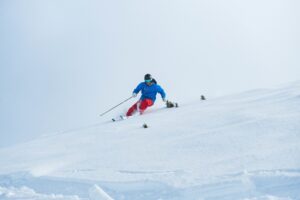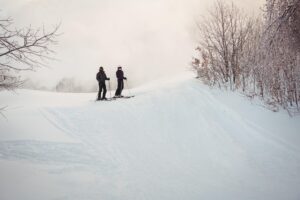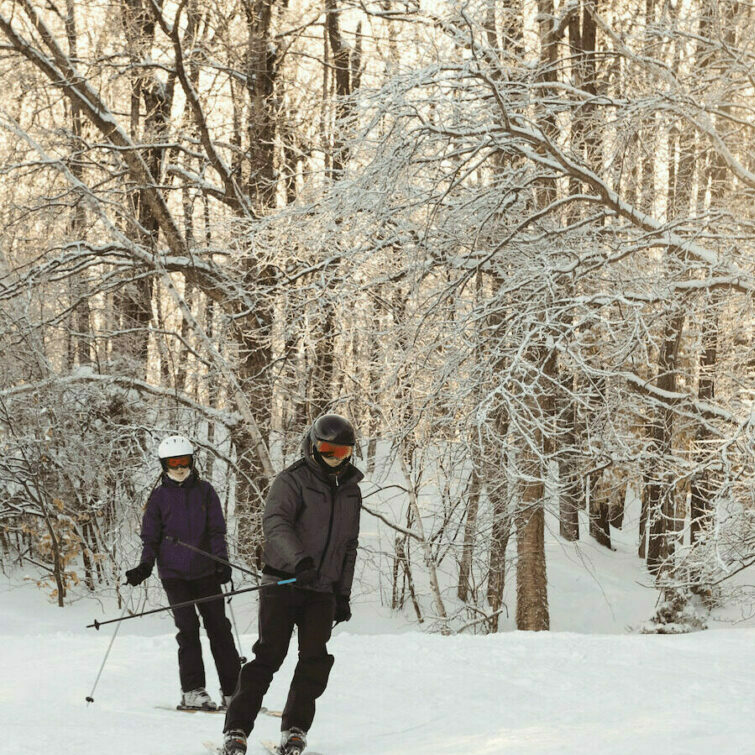How to cope with motion sickness while skiing
Whether you’re a beginner or a seasoned winter sports enthusiast, skiing is an exhilarating and enjoyable activity set amid some of the world’s most stunning mountain locations. Ski holidays bring wonderful family times and fabulous get aways with friends – speeding down the slopes, high altitude lunch stops and cosy apres ski gatherings around the fire.
Sounds pretty dreamy doesn’t it? So much so, we don’t really want to spoil it all with thoughts of motion sickness.
However, if you’ve ever experienced motion sickness while skiing, commonly known as “ski sickness”, the thrills can become spills, turning an epic adventure into a bit of challenge. But is doesn’t have to be all downhill if you do suffer from ski sickness.
In this blog, we will explore what ski sickness is, why it happens, and most importantly, how to cope with it to ensure a more enjoyable skiing experience.
Ski sickness symptoms
Sufferers of ski sickness, also known as Hausler’s disease – named after Rudolf Hausler the Bern University Hospital professor who is credited with discovering the condition1/2 – experience similar symptoms to those suffering from car sickness or sea sickness.1
These travel sickness symptoms include feeling sick or being sick, dizziness, a headache, feeling cold and going pale and sweating.3
As with other forms of motion sickness it’s believed to be due to contradictory sensory information from the eyes and ears to the brain.3 These confusing messages cause you to feel unwell.3
Why does ski sickness happen?
When skiing down the slopes, the visual cues of rapidly moving surroundings might contradict the sensory signals from the inner ear, which detects motion and balance.4 This sensory mismatch leads to symptoms like dizziness, nausea, and even vomiting.4
According to Hausler’s study it tends to happen more when there’s less visibility on the slopes or during a white-out and people sensitive to motion sickness generally are more prone to ski sickness.4 He says it may even be triggered by wearing ski boots, the rigidity possibly hampering sensory messages from the foot to the brain.1
Psychological factors such as a fear of heights, high speed, atmospheric pressure changes, a fall – and a liquid lunch thrown in! – may also exacerbate the symptoms, according to his study.1
His research is based on 11 ski sickness sufferers but he estimates it may affect up to 10 per cent of skiers at some stage.1


The difference between altitude sickness and ski sickness
Although some of the symptoms experienced by skiers can be similar to altitude sickness, the latter is caused by travel to altitudes of more than 2,500m above sea level too quickly.5
Symptoms can feel similar to a bad hangover and usually develop any time from six to 24 hours after reaching high altitudes.5 They’re often worse at night and include a headache, dizziness, tiredness, feeling and being sick, a loss of appetite and shortness of breath.5
It’s possible to have altitude sickness skiing, if you’re heading to higher up resorts. It can take a few days for the body to adjust to a change in altitude.5
There are self-help ways to prevent it including avoiding strenuous exercise for the first 24 hours after arrival, avoid smoking and alcohol, drink plenty of water and eat a diet that’s light but high in calories.2
Tips to cope with ski sickness
Choose the right skiing conditions
If you are prone to motion sickness, choose skiing conditions that are less likely to trigger it. Opt for easier slopes with fewer obstacles, as navigating through bumpy and challenging terrain might exacerbate your ski sickness.6
Be prepared
Eating a light, carb-based meal a couple of hours before a journey is something we often recommend in our blogs to help prevent travel sickness.7 The same can apply before you hit the slopes, go for something like cereal or bread but avoid anything rich or fatty that could upset your stomach. Make sure you stay hydrated too and keep water handy.
Acclimatise gradually
If you are new to skiing or haven’t not been on the slopes for a while, ease yourself into it. Start with gentle slopes and shorter sessions, allowing your body to adjust to the movement gradually.
Take frequent breaks
This is particularly relevant if you have motion sickness prone youngsters.8 Regular breaks during your skiing sessions can provide relief to your senses and prevent motion sickness from escalating. Use these breaks to get refreshment, rest and take in the stunning surroundings.
Focus on the horizon
Focussing a little above the horizon while in a car or boat can help to relieve or prevent travel sickness.7 While skiing, try to the same if the horizon is visible or focus on a fixed point in the distance. This can help reduce the sensory conflict between what your eyes see and what your inner ear perceives, mitigating motion sickness symptoms.7
Motion sickness remedies
Aside from removing your skis – which Hausler concluded was the quickest way to relieve ski sickness – he suggested that standard travel sickness medication could be an option for ski sickness sufferers.2
If self-help methods aren’t working and you wish to find out more about suitable treatments, speak to your local pharmacist for advice.
Kwells travel sickness tablets for adults and Kwells Kids for children aged four and over contain an active ingredient called hyoscine hydrobromide which temporarily reduces the effect of movement on the balance organs of the inner ear and the nerves responsible for nausea.8
Because Kwells tablets melt in the mouth, absorption into the bloodstream is very rapid and they can be taken up to 20–30 minutes before a journey or at the onset of travel sickness.8


Don’t let ski sickness ruin your trip
Ski sickness can be an unpleasant aspect of winter sports for some, but it doesn’t have to ruin your ski trip.
With a little preparation and self-care, you can make skiing a more enjoyable and memorable experience without the unpleasantness of motion sickness. Happy skiing!
Kwells 300 microgram tablets. For the prevention of travel sickness, suitable for adults and children aged 10+. Contains Hyoscine Hydrobromide 300 microgram. Kwells Kids 150 microgram tablets. For the prevention of travel sickness, suitable for children aged 4+. Contains Hyoscine Hydrobromide 150 microgram. Always read the label
References
1. https://www.swissinfo.ch/eng/slope-motion–professor-identifies-ski-sickness/2620644
2. https://en.wikipedia.org/wiki/Ski_sickness
3. https://www.nhs.uk/conditions/motion-sickness/
4. https://pubmed.ncbi.nlm.nih.gov/7762376/
5. https://www.nhs.uk/conditions/altitude-sickness/
6. https://newtoski.com/skiing-with-vertigo/
7. https://patient.info/travel-and-vaccinations/health-advice-for-travel-abroad/motion-travel-sickness
8. https://www.medicines.org.uk/emc/product/11746/pil#gref

